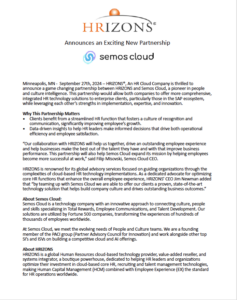 Twenty years as an HR consultant has taught me one thing: the more things change, the more they stay the same. The one constant is something that I heard on my first day in the industry; yet the same phrase still pervades our daily lives in HR: “HR needs to be more strategic.”
Twenty years as an HR consultant has taught me one thing: the more things change, the more they stay the same. The one constant is something that I heard on my first day in the industry; yet the same phrase still pervades our daily lives in HR: “HR needs to be more strategic.”
My start in HR came before much automation. It came before the internet. It came before terms Talent Management, SaaS, Talent Acquisition, Data Warehouse or Cloud were even in our lexicon. So how could we have advanced so much and yet advanced so little? The reason is that HR’s becoming a strategic partner to the business is not as much about changes in technology or terminology as much as it is in changes in HR, its skills and how it works with the business.
Much like a child at a large family gathering trying to earn a spot at the “grown up” table, in my time in the industry I have found three keys that can help HR earn its seat at the table to be a strategic partner with the business.
KEY #1: Understand the Busines
As a consultant I often get to interview business executives on the role of HR and what it could be doing differently. The overwhelming answer I hear on how HR can better support the business is a simple one: “Understand the business.” While this seems simplistic, what is means is that HR can better support all facets of talent by doing some homework and understanding:
- Business strategy
- Business drivers
- Talent needs and scarcity
- Skill and competency requirements
This is particularly true in designing attraction and retention programs. Leaders in best practice organizations encourage or even require recruiters to shadow employees in the business for a day to understand the job requirements, the skills needed and to be able to articulate that to candidates. Small investments like this can help HR truly understand the business and the talent needed to be successful in the business.
KEY #2: What’s important to HR is different than what’s important to the business
When working with HR organizations I often ask about reporting and the availability of HR/Talent Management reports to business leaders. Most executives are happy with the level of reporting they have available, and then provide me with examples such as Time to Fill, Headcount Report, Performance Distribution Report and Turnover Report. “Yes,” I say, “These are good basic reports. For HR!”
The problem I usually encounter is the HR reports that are being shared with business leaders do nothing to help a business leader run the business. They provide HR feedback on how HR is doing with its processes. A business leader doesn’t care about time to fill as much as quality of hire. A recruiter can always hire someone quickly, but is it the right person? Headcount reports are only used to police budgetary constraints. A performance distribution report shows HR how it is running the process, not whether the performance/compensation system adequately differentiates performance and what is being done to ensure my high performers are being rewarded and staying with the company. And while turnover reports are important, they are much more valuable when segmented by key groups such as by skill, performance, manager, etc.
I have found one of the most enlightening experiences is to meet with a group of business leaders to explore what types of reporting they would like to see from HR. The answers are usually creative and very much outside of the traditional HR box, like, “What are the key correlative factors with employee productivity?” or “What is the cost impact to my bottom line if a high performer leaves?” Although this brainstorming exercise does not always produce metrics that are easy to create, those that can be calculated are things that the business leaders can use to help run the business!
KEY #3 – HR needs to skill up
Using the two keys above as guidance, the HR professional who earns the seat at the table has a different set of skills than a traditional HR professional. The days of HR being the enforcer of policies and procedures, a paper pusher in a functional role, are gone. The keys above show the need for consultative skills, business acumen and a strong analytical sense.
As the skillsets for HR evolve, HR must examine itself to determine what capability exists within the function. But most HR organizations I see are still overweighted in the old HR skillsets, making the evolution into strategic partner more difficult if not impossible.
Through a combination of hiring for future skills and training existing professionals in the skills needed to become a strategic partner, HR organizations can move up the strategic maturity curve.
As I said in the beginning, the one constant over my 20 years in the HR industry has been HR trying to gain the role as a strategic business partner. I am hoping that 20 years from now, instead of saying the same thing, that we have finally gotten our seat at the table.
Doug Rippey is the Line of Business Leader for Workforce Analytics, Workforce Planning and Recruiting at HRIZONS, a consulting company with a strong presence in the Americas. He has consulted with organizations around the world, but still fondly remembers growing up sitting at the kid’s table.



